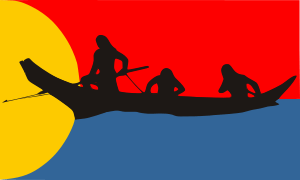Clatsop facts for kids
| Lā'k!ēlak | |
|---|---|

Clatsop flag
|
|
| Total population | |
| 200 | |
| Languages | |
| Chinookan, English, Chinook Jargon | |
| Related ethnic groups | |
| Tillamook |
The Clatsop are a small tribe of Native Americans. They speak a language from the Chinookan family. In the early 1800s, they lived along the northwestern coast of what is now Oregon. Their land stretched from the mouth of the Columbia River south to Tillamook Head.
Contents
Understanding the Clatsop Language
The name Clatsop comes from the original language, łät'cαp. This word means "place of dried salmon". At first, Clatsop was just the name of one village. Later, it became the name for the whole tribe.
The Clatsop people spoke a special kind of Lower Chinookan language. This language is now extinct. By the time the Lewis and Clark explorers met them, most Clatsops also spoke Chinook Jargon. Some even spoke Nehalem. This was because they often married and lived with the Tillamook tribe.
Chinook Jargon was a trade language. It was used by many different groups across the Pacific Northwest. Many local place names come from Chinook Jargon. For example, Ecola Creek and Park means "whale".
Clatsop History and Culture
The Clatsop tribe was first mentioned in 1792. This was in the journals of Robert Gray. In 1805, members of the Lewis and Clark Expedition met them at the mouth of the Columbia River. The explorers even named their winter camp Fort Clatsop after the tribe. The main Clatsop village was about 7 miles (11 km) away. Clatsop County, Oregon is also named after this tribe.
According to William Clark's journals, about 200 Clatsop people lived in three villages. Their homes were large longhouses made from cedar planks. Clatsop people often visited the fort. They traded furs and other goods for items made by Europeans.
Clatsop Social Life
The tribe had leaders, sometimes called "chiefs". However, their society was flexible. Families often grouped together in small villages. They also set up seasonal camps near places where they could find food.
The Clatsop shared salmon, berries, and hunting tips with the Lewis and Clark explorers. Their interactions were mostly about trading. The fort was open for trade only 24 days that winter. This might be because coastal tribes already traded with British traders. The Clatsop and Chinook tribes asked for higher prices for their goods. This happened when the explorers had fewer trade items left. Only two Clatsop people, Coboway and Cuscalar, are often mentioned in the explorers' journals.
Land and Recognition Challenges
In 1851, the Clatsop tribe offered to give 90 percent of their land to the U.S. Government. This agreement, like many others in the Northwest, was never officially approved by the Senate. Unlike some other tribes, the Clatsop were not forced to move to a reservation. They were one of the few tribes in Oregon who were not part of a plan to move them to reservations.
The last known speaker of the Tillamook language passed away in 1972. Some Clatsop-Nehalem people tried to join the Confederated Tribes of Siletz and the Confederated Tribes of Grand Ronde. However, their requests were not approved.
In 2001, the Chinook tribe, which included some Clatsop members, gained official federal recognition. This happened through an order from President Clinton. But this status was later reversed by the Bush administration. The 200th anniversary of the Lewis and Clark Expedition (2004–2006) brought new attention to the Clatsop and Chinook tribes.
Today, the Clatsop tribe does not have formal federal recognition. They have faced challenges in keeping their group identity strong. About 200 members now form an unofficial group called the Clatsop-Nehalem Confederated Tribes of Oregon. They have joined with the Salishan-speaking Nehalem (Tillamook) tribe. This tribe once lived near Tillamook Bay. Many Clatsop people are also part of the (unrecognized) Chinook Tribe. Other tribes in the region, like the Quinault, Siletz, and Grand Ronde, also have members with Clatsop heritage. Clatsop descendants continue to practice their culture and ceremonies within their families and communities.
In May 2020, the North Coast Land Conservancy gave 18.6 acres (7.5 hectares) of land back to the Clatsop-Nehalem Confederated Tribes. This land is part of the Neawanna Point Habitat Preserve. It is located on the north Oregon coast, between Seaside and Gearhart, Oregon. The area includes saltmarsh and Sitka spruce forest. It is on the Necanicum Estuary, where the Neawanna and Neacoxie creeks meet the Necanicum River before it flows into the Pacific Ocean. Clatsop ancestors lived here long ago, but they were later forced to leave. The Clatsop knew this area as Ne-ah-coxie, meaning "place of little pines". This was the first land owned by the tribes since they were displaced almost 200 years ago.
Where to Learn More
The Tillamook County Pioneer Museum in Tillamook has exhibits about the history of the Clatsop people.
See also
 In Spanish: Clatsop para niños
In Spanish: Clatsop para niños

